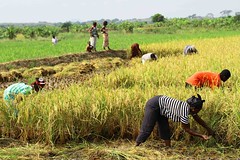 |
| Okyereko Rice Cooperative Association in Ghana |
Sounds absurd, I know, but achieving a number of development goals – meeting global food security needs and building better futures (essentially, eradicating poverty) — has a lot to do with water for food. That is, availability and access to clean water for poor people in rural areas that rely on agriculture for their employment, food, nutrition and health.
Growing food requires a lot of water. Globally, agricultural production uses 70 percent of the world’s fresh water. Last time I checked, that’s HUGE, especially when you start to think about water scarcity in regions like the Middle East and parts of sub-Saharan Africa. These places suffer from exponential population growth and quickly changing climates leading to erratic and more violent weather patterns and events.
Already 1.2 billion people face physical water scarcity and 1.6 billion lack adequate access to water. So, the sheer number of people in the world now, plus the 3 billion projected to share the planet and its resources by 2050, definitely adds to the pressure. How are we going to feed, bathe, clothe and employ ourselves as our needs just continue to grow and grow?
By most accounts, it doesn’t have to be a doom and gloom scenario, but it requires that we get smart about how we use water, how we invest in agriculture and how we ensure fair and adequate access to water. So what can we do? Oftentimes, some of the first responses on how to grow more food is to use more water. To a certain point, the more rain you get, the healthier your soils and the more food you can produce.
About 40 percent of the world’s farmland is irrigated, mainly in China, India, the Middle East and the southwest United States – places where it’s really hot and dry. The rest is rain-fed agriculture. But do we have enough water to irrigate all or even the majority of the world’s farmland? Probably not, if we want to be able to use water for municipal and industrial uses, too. Though investing in small-scale and drip irrigation in rural areas, particularly in Africa, could have tremendous benefits, the potential for improving productivity are enormous.
For instance, in Burkina Faso, a country in West Africa, small-scale irrigation projects and better water management practices helped almost 7,000 small-scale farmers in some regions double their rice yields and their incomes.
Let’s not forget the enormous impact that climate change will have on all of these massively complicated challenges. Most of the world’s poor farmers rely on rain-fed agriculture, and more than 50 percent of our food is grown under rain-fed conditions. As climate change affects how much rain falls, when it falls and where it falls, millions of smallholder farmers are at risk of failed harvests without better-risk management tools, water, soil, land management practices and adaptation to new these new conditions. Climate change could reduce yields in parts of Africa by 50 percent as early as 2020 – that’s only 10 years away!
But what about all the social aspects of access to water? Particularly in rural areas, for women who dominate the number of smallholder farmers in Africa. Improving governance and rights around access to water and other farming inputs in many places will be just as important as investing in the infrastructure and the technology to bringing the water closer to communities and their farms. When women get the same access to resources as men, their productivity is shown to increase by 20 percent. Women on average invest up to 90 percent of their earnings on their families. So, improving women’s growing and earning potential with better access to water can help feed and educate generations to come.
So, let’s not let poor farmers become thirstier for food. Let’s make smart investments now – in agriculture, in water resource management, in governance, in women’s access – and eradicate poverty and food insecurity before the food and climate crises get worse with less water for more people.

No comments:
Post a Comment